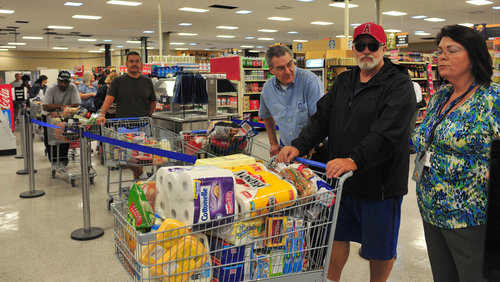Last night, I was out at dinner with a close group of friends.
It was a fairly hilarious situation.
There were only about 3 or 4 full tables in the restaurant, so you would have expected us to get first-class service.
But it took almost an hour and a half for us to get our entrees.
We handled the whole situation in good humor, but it definitely got to us at times.
This is a great example, yet again, of the power of expectations. All of us have a roughly 20-30 minute wait-time anchor in our heads. When our wait goes past that point, we start to get a little antsy, a little frustrated.
When it goes way past that point, we treat it as a tragedy of the highest order.
But I don’t want to write to you about the “iron law of expectations”—a common topic in these emails. I want to write to you about what I call the “checkout race”, which is what the whole situation last night brought to mind.
Picture the last time you were in a checkout line at a grocery store.
You probably scanned all of the different lines and picked the one that looked the shortest. Or, if you were feeling a bit clever that day, you might have picked the one that was a bit longer but moving more quickly.
If you were lucky, your choice paid off and you were walking out the door with your bags of goodies before your competitors in the other lines.
Now, let’s imagine something a little different. Instead of victoriously sliding through the line and getting out ahead of all the other customers, I want you to imagine the following: you picked the shortest line and, instead of moving quickly, your line lurched forward… one slow person at a time.
In fact, you watched as a bunch of people who got into their lines way later than you sped through the checkout process.
How frustrating is that?
Luckily, there are some people in this world that are obsessed with lines… and some of them spend their time thinking about the psychological dynamics of waiting in these lines.
And do you know what solution they came up with to prevent this?
Yep!
It’s called the “snaked queue” (shoddily drawn picture below).
This is where you have everyone wait in one long line that feeds into multiple different check-out lanes, bank tellers, etc. When the next bank teller or check-out clerk becomes available, the person at the front of the snaked line gets served.
This way, you save the customers from the stress of choosing the right line, and you get rid of the rage-inducing sense of unfairness that comes alive when the customers that queued up after you get helped first.
This was on my mind last night as we sat at our table. Why? Because there was a couple that sat down for dinner after us but got served well before us.
Since we had a table of 8, and they had a simple duo, this didn’t bother me too much—they weren’t in the same customer category. It would have been truly enraging, though, if they had a party of equal size. My evolutionary-crafted fairness detection system would have been in full alarm mode. Instead, it was merely purring away… ready to protect me if necessary.
Until tomorrow,
Jason





